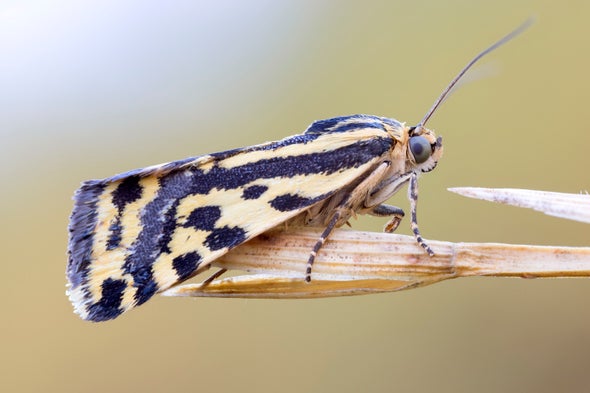(单词翻译:单击)
听力文本
This is Scientific American's 60-second Science, I'm Susanne Bard.
About 12,000 species of tiger moth exist on Earth. Some of them swoop and dive out of harm's way when a hungry bat tries to make them a meal. But other tiger moth species are more blasé—they just don't bother to flee from the hungry bats.
"And I really just wanted to know why. Why the difference? What factors might be influencing whether a species is more or less likely to perform these evasive maneuvers?"
Wake Forest University behavioral ecologist Nick Dowdy. He says it's a matter of taste—some of the moths are delicious, but others are toxic and taste terrible. When the airborne predators catch these unappetizing moths, they'll spit them out, giving the insects a new lease on life.
In a field experiment, Dowdy and his colleague William Conner filmed how five different species of tiger moths responded to bat attacks.
"And what we found was that those species which were really toxic—so when the bats captured them, they almost never ate them—those species were much more likely to be what we call nonchalant, species that do not perform evasive maneuvers very often. On the other hand, species that were really palatable were much more likely to perform those evasive maneuvers, almost, in a sense, sort of hedging their bets. Because if they don't make that escape, if they are captured by a bat, those species are more likely to be eaten."

Another factor is that evasive maneuvers have their own set of risks, which may be why unpalatable moths tend to avoid them. For example, diving away from bats burns fuel, gives the insects less time to seek out mates and could expose them to other perils, such as getting stuck in water.
"Or there could be predators on the ground like mice and other mammals."
The study is in the journal Frontiers in Ecology and Evolution.
Dowdy is now trying to identify the chemical compounds responsible for making some tiger moths taste bad. Once those findings are in, chemical analysis of museum specimens could help reveal how rare, endangered or even extinct insects have behaved around predators.
"We can still study animal behavior even without a living organism. That's, I think, pretty amazing."
Other animals with conspicuous warning signals, such as garishly colored poison dart frogs and foul-smelling skunks are also known to be slow movers. Perhaps if you're deadly, toxic or just plain stink, it can pay to be lazy.
Thanks for listening for Scientific American's 60-second Science. I'm Susanne Bard.
参考译文
这里是科学美国人——60秒科学系列,我是苏珊娜·巴德。
地球上大约有12000种虎蛾。当饥饿的蝙蝠试图捕食虎蛾时,其中一些虎蛾会突然俯冲到安全地方。但其它种类的虎蛾却无动于衷——它们只是懒得逃避饥饿的蝙蝠。
“我真的想知道原因。为什么会有这种差异?哪些因素可能会影响虎蛾更愿意或更不愿意实施逃避行为?”
维克森林大学的行为生态学家尼克·道迪说到。他说这与口味有关,有些蛾子的味道很美味,但其它则有毒,而且味道很糟糕。飞行中的捕食者捉到这些倒胃口的蛾子时,会把它们吐出来,让蛾子重获新生。
在现场实验中,道迪及同事威廉·康纳拍摄了五种不同种类的虎蛾面对蝙蝠攻击时的反应。
“我们发现,真正有毒的那些虎蛾,蝙蝠捉到它们时几乎从不吃掉它们,这些虎蛾更有可能是我们所说的漠不关心的物种,它们不常实施逃避行为。另一方面,真正美味可口的虎蛾更可能实施逃避行为,在某种意义上,这可以算是两面下注。因为如果它们逃走,如果被蝙蝠抓住,它们就更有可能被吃掉。”
另一个因素是,逃跑策略本身也存在一系列风险,这可能就是为什么难吃的虎蛾选择逃避的原因。例如,潜入水中逃离蝙蝠会消耗能量,减少其寻找配偶的时间,并可能使它们面临其他危险,比如被困在水中。
“或者地面上可能有老鼠和其它哺乳动物等捕食者。”
这项研究发表在《生态学与进化前沿》期刊上。
道迪现在正试图找出导致某些虎蛾变得难吃的化合物。一旦相关发现出炉,对博物馆标本进行化学分析将有助于揭示稀有、濒危甚至灭绝昆虫在捕食者周围的行为方式。
“即使没有活体有机物,我们仍可以研究动物的行为。我觉得这真是太棒了。”
其它有明显警告信号的动物,如七彩斑斓箭毒蛙和气味难闻的臭鼬,也被认为是行动迟缓的动物。也许,如果你具备致命能力,有毒或者仅仅是臭气熏天,那你可以选择懒惰。
谢谢大家收听科学美国人——60秒科学。我是苏珊娜·巴德。
译文为可可英语翻译,未经授权请勿转载!
重点讲解
重点讲解:
1. out of harm's way 在安全的地方;没有危险;
For parents, it is an easy way of keeping their children entertained, or simply out of harm's way.
对父母来说,这是一个能让孩子们开心或者说是让他们远离危险的简单方法。
2. hedge one's bets 两面下注;做两手准备;
NASA is hedging its bets and adopting both strategies.
美国航空航天局做了两手准备,两套策略双管齐下。
3. seek out 寻找到;找出;
Now is the time for local companies to seek out business opportunities in Europe.
对于当地公司来说,现在是时候去欧洲寻求商机了。
4. expose sb. to sth. 使面临,使遭受(危险或不快);
Do not expose babies to strong sunlight.
不要让婴孩受到强烈的阳光照射。


